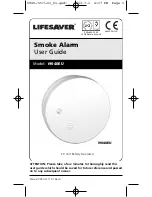
• In the garage. Products of combustion are present when you start
your automobile.
• Less than 10cm from the peak of an “A” frame type ceiling.
• In an area where the temperature may fall below 0ºC or rise above
40ºC, such as garages and unfinished attics; this should also include
electrical boxes exposed to these environments.
• In dusty areas. Dust particles may cause nuisance alarm or failure to
alarm.
• In very humid areas. Moisture or steam can cause nuisance alarms.
• In insect-infested areas.
• In areas where the Relative Humidity (RH) is above 93%.
• Smoke alarms should not be installed within .9m of the following: the
door to a kitchen, the door to a bathroom containing a tub or shower,
forced air supply ducts used for heating or cooling, ceiling or whole
house ventilating fans, or other high air flow areas.
• Kitchens. Normal cooking may cause nuisance alarms. If a kitchen
alarm is desired, it should have an alarm silence feature or be a
photoelectric type.
• Near fluorescent lights. Electronic “noise” may cause nuisance alarms.
• Smoke alarms are not to be used with detector guards unless the
combination (alarm and guard) has been evaluated and found suitable
for that purpose.
• In front of forced air supply ducts used for heating and air
conditioning, near ceiling fans,or other high air flow areas.
2. Locations To Avoid
0940-7217-01_V1.qxd:_ 2013.7.1 4:18 PM Page 7
















